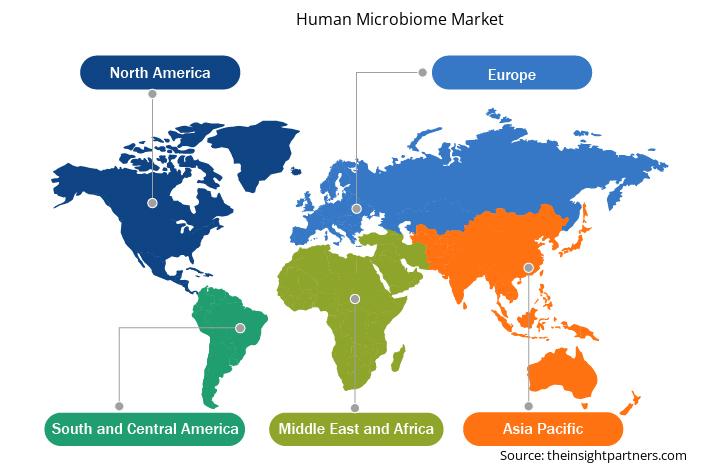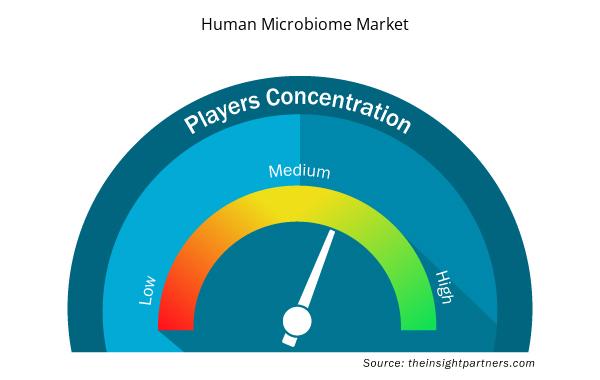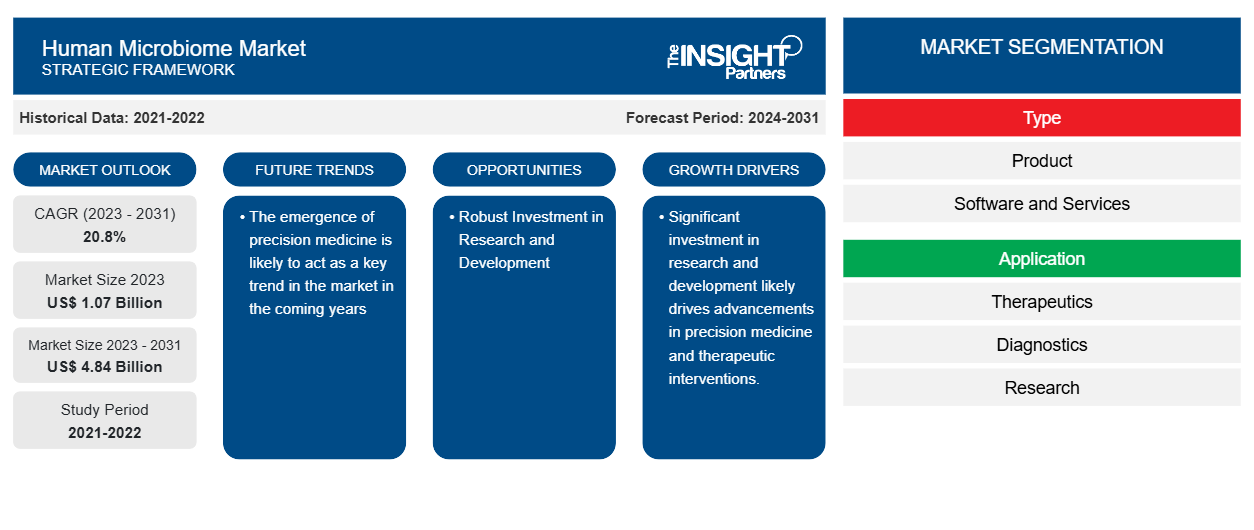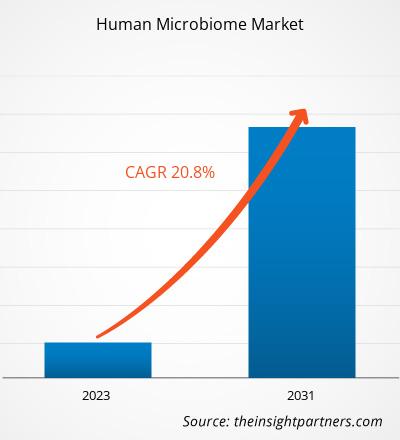Si prevede che la dimensione del mercato del microbioma umano raggiungerà i 4,84 miliardi di dollari entro il 2031, rispetto agli 1,07 miliardi di dollari del 2023; si stima che il mercato registrerà un CAGR del 20,8% nel periodo 2023-2031. È probabile che l'emergere della medicina di precisione agisca come una tendenza chiave nel mercato nei prossimi anni.
Analisi del mercato del microbioma umano
La crescita, l'innovazione e le dinamiche di mercato del settore del microbioma umano sono fortemente influenzate dagli investimenti effettuati dai principali attori del mercato. I principali attori sono impegnati in investimenti significativi in ricerca e sviluppo per creare nuovi probiotici, diagnosi e trattamenti basati sul microbioma. Queste spese stimolano l'innovazione, identificando nuovi ceppi, modalità di azione e usi medicinali. Gli studi clinici ricevono una grande quantità di finanziamenti, il che è essenziale per dimostrare l'efficacia e la sicurezza dei prodotti basati sul microbioma. Ad esempio, Kanvas Biosciences, un pioniere nella tecnologia di mappatura del microbioma, ha annunciato un round di finanziamenti Pre-Series A da 12 milioni di dollari USA a giugno 2023. La tecnologia di piattaforma proprietaria dell'azienda, che ha il potenziale per trasformare lo sviluppo di farmaci per le malattie legate al microbioma, sarà ulteriormente sviluppata con l'aiuto dell'investimento. Queste partnership semplificano la condivisione di risorse, know-how e progressi tecnologici, accelerando lo sviluppo del prodotto.
Inoltre, investitori di rilievo come Seventure Partners e Flagship Pioneering stanno finanziando attivamente aziende che analizzano i dati del microbioma, riflettendo un crescente riconoscimento del ruolo del microbioma nella salute. Pertanto, investimenti significativi in ricerca e sviluppo probabilmente guidano i progressi nella medicina di precisione e negli interventi terapeutici, creando così ampie opportunità nel mercato.
Panoramica del mercato del microbioma umano
Nuovi prodotti farmaceutici in fase di sviluppo, sviluppo e miglioramento dei prodotti e un aumento delle partnership strategiche sono fattori significativi che avvantaggiano il mercato delle terapie del microbioma in Cina. Xbiome Inc., un'azienda leader nella terapia del microbioma basata sull'intelligenza artificiale, ha acquisito il programma M201 in fase clinica da Assembly Biosciences, Inc., un'azienda biotecnologica in fase clinica coinvolta nello sviluppo di trattamenti all'avanguardia per disturbi virali come l'epatite B. Si prevede che la crescente prevalenza di disturbi target guiderà la crescita del mercato del microbioma umano . In Cina, in futuro, mentre la ricerca continua a rivelare il ruolo significativo del microbioma umano in varie condizioni di salute, c'è un crescente interesse nello sviluppo di terapie basate sul microbioma. Ciò è particolarmente vero per condizioni come disturbi gastrointestinali , malattie autoimmuni e disturbi metabolici, in cui l'influenza del microbioma è ben consolidata. Il potenziale della terapia del microbioma come trattamenti più efficaci e personalizzati rappresenta un'opportunità promettente per l'espansione del mercato. Secondo le statistiche del National Institute of Health pubblicate a giugno 2021, in Cina la prevalenza della sindrome dell'intestino irritabile è del 2,3-15,8%.
Personalizza questo report in base alle tue esigenze
Riceverai la personalizzazione gratuita di qualsiasi report, comprese parti di questo report, o analisi a livello nazionale, pacchetto dati Excel, oltre a usufruire di grandi offerte e sconti per start-up e università
- Scopri le principali tendenze di mercato in questo rapporto.Questo campione GRATUITO includerà analisi di dati che spaziano dalle tendenze di mercato alle stime e alle previsioni.
Driver e opportunità del mercato del microbioma umano
Iniziative governative
Le iniziative governative e i programmi di supporto hanno un impatto significativo sulla crescita del mercato del microbioma umano. I governi spesso erogano ingenti somme di denaro e sovvenzioni per studi sul microbioma umano. Questa assistenza finanziaria accelera lo sviluppo di nuovi trattamenti, dispositivi e diagnosi. I finanziamenti supportano l'innovazione e la commercializzazione di prodotti da parte di startup e piccole e medie imprese (PMI) nel settore del microbioma umano. Ad esempio, l'NIH lancia un progetto sul microbioma umano. Questo progetto può trasformare il modo in cui comprendiamo la salute umana e preveniamo, diagnostichiamo e trattiamo varie condizioni. Parte della Roadmap for Medical Research dell'NIH, l'Human Microbiome Project assegnerà 115 milioni di dollari ai ricercatori nei prossimi cinque anni. La terapia basata sul microbioma è un campo in forte espansione. L'interesse per le terapie basate sul microbioma è aumentato a causa della recente approvazione di Vowst, un farmaco della Seres Therapeutics, per il trattamento delle infezioni da C. difficile. La riclassificazione dei probiotici del microbioma come prodotti farmaceutici è una tendenza in crescita che il recente sviluppo di terapie basate sul microbioma potrebbe aver influenzato. Nell'Unione Europea (UE) si stanno compiendo notevoli progressi per riclassificare i probiotici vaginali come farmaci.
Solidi investimenti in ricerca e sviluppo
Il potenziale del microbioma umano di trasformare il settore sanitario ha portato a un recente aumento degli investimenti in ricerca e sviluppo. Miliardi di batteri , funghi e virus che vivono nel e sul corpo umano costituiscono il microbioma umano, che è essenziale per una buona salute e per la prevenzione e il trattamento delle malattie. Lo sviluppo di terapie basate sui microbiomi sta ricevendo finanziamenti significativi da startup biotecnologiche e aziende farmaceutiche. Una delle prime startup di microbiomi in India, Xome Life Sciences, ad esempio, si concentra su ogni aspetto del microbioma. L'azienda sta sviluppando strumenti prognostici, diagnostici e terapeutici basati sui microbiomi per aiutare le persone a vivere vite più sane e prendere decisioni migliori sulla propria salute. Un recente trattamento approvato dalla FDA sviluppato da Seres Therapeutics per l'infezione ricorrente da Clostridium difficile, una malattia gastrointestinale presa di mira dai farmaci basati sul microbioma. Vedanta Biosciences ha raccolto ingenti fondi per costruire la propria pipeline di immunoterapie derivate dai microbiomi per disturbi autoimmuni e cancro. Investitori di rilievo come Seventure Partners e Flagship Pioneering stanno finanziando attivamente aziende che analizzano i dati del microbioma, riflettendo un crescente riconoscimento del ruolo del microbioma nella salute. Pertanto, si prevede che investimenti significativi in ricerca e sviluppo guideranno i progressi nella medicina di precisione e negli interventi terapeutici, creando così ampie opportunità nel mercato.
Analisi della segmentazione del rapporto di mercato del microbioma umano
I segmenti chiave che hanno contribuito alla derivazione dell'analisi di mercato del microbioma umano sono tipologia, applicazione, tipo di malattia e geografia.
- Il mercato del microbioma umano, per tipo, è diviso in prodotto e software e servizi. Il segmento di prodotto è ulteriormente biforcato in probiotici e prebiotici. Il segmento di prodotto ha detenuto una quota maggiore del mercato del microbioma umano nel 2023 e si prevede che registrerà un CAGR più elevato nel periodo 2023-2031.
- In base all'applicazione, il mercato del microbioma umano è suddiviso in terapeutica, diagnostica e ricerca. Il segmento terapeutico ha rappresentato la quota maggiore del mercato del microbioma umano nel 2023.
- In base al tipo di malattia, il mercato del microbioma umano è segmentato in obesità, diabete, disturbi autoimmuni, cancro, disturbi gastrointestinali e altri. Il segmento dei disturbi gastrointestinali ha detenuto la quota maggiore del mercato del microbioma umano nel 2023.
Analisi della quota di mercato del microbioma umano per area geografica
L'ambito geografico del rapporto di mercato sul microbioma umano è principalmente suddiviso in 5 regioni principali: Nord America, Europa, Asia Pacifico, Medio Oriente e Africa e Sud e Centro America. Il Nord America ha dominato il mercato nel 2023. La crescita del mercato in Nord America è caratterizzata da solide attività di ricerca sul microbioma umano, maggiori finanziamenti per la biotecnologia, un aumento della consapevolezza della salute tra la popolazione e un aumento della domanda di probiotici e prebiotici per il trattamento di malattie croniche. Le applicazioni del microbioma umano stanno crescendo rapidamente nel campo della biotecnologia; sta emergendo come una terapia significativa per il trattamento di varie malattie croniche. La ricerca e lo sviluppo di terapie basate sul microbioma umano sono cresciuti in modo significativo negli Stati Uniti, portando a maggiori investimenti privati e progressi nell'ingegneria del microbioma ambientale. Secondo un articolo pubblicato su Nature nel 2019, nell'ultimo decennio, gli Stati Uniti hanno effettuato il più grande investimento di circa 1 miliardo di dollari USA nella ricerca sul microbioma umano. Circa il 20% di questo finanziamento è stato utilizzato per due fasi dell'Human Microbiome Project (HMP), che mira a creare le risorse di ricerca necessarie per studiare il microbioma umano. L'HMP è stato lanciato nel 2007 per stabilire una cassetta degli attrezzi completa composta da set di dati di riferimento, tecniche computazionali, metodi analitici e protocolli clinici. Questo sforzo si è dimostrato vincente, poiché circa il 75% dei beneficiari di sovvenzioni NIH per la ricerca sul microbioma dal 2012 al 2016, lavorando su oltre 100 malattie, si è basato su dati e strumenti HMP nelle loro domande di finanziamento. Finanziato dagli US National Institutes of Health (NIH), l'HMP ha notevolmente accelerato la ricerca sul microbioma umano sia negli Stati Uniti che su scala globale. L'aumento delle attività di ricerca offrirà probabilmente opportunità per lo sviluppo di terapie innovative sul mercato.
Approfondimenti regionali sul mercato del microbioma umano
Le tendenze regionali e i fattori che influenzano il mercato del microbioma umano durante il periodo di previsione sono stati ampiamente spiegati dagli analisti di Insight Partners. Questa sezione discute anche i segmenti e la geografia del mercato del microbioma umano in Nord America, Europa, Asia Pacifico, Medio Oriente e Africa e America meridionale e centrale.

- Ottieni i dati specifici regionali per il mercato del microbioma umano
Ambito del rapporto di mercato sul microbioma umano
| Attributo del report | Dettagli |
|---|---|
| Dimensioni del mercato nel 2023 | 1,07 miliardi di dollari USA |
| Dimensioni del mercato entro il 2031 | 4,84 miliardi di dollari USA |
| CAGR globale (2023-2031) | 20,8% |
| Dati storici | 2021-2022 |
| Periodo di previsione | 2024-2031 |
| Segmenti coperti | Per tipo
|
| Regioni e Paesi coperti | America del Nord
|
| Leader di mercato e profili aziendali chiave |
|
Densità degli attori del mercato del microbioma umano: comprendere il suo impatto sulle dinamiche aziendali
Il mercato del microbioma umano sta crescendo rapidamente, spinto dalla crescente domanda degli utenti finali dovuta a fattori quali l'evoluzione delle preferenze dei consumatori, i progressi tecnologici e una maggiore consapevolezza dei benefici del prodotto. Con l'aumento della domanda, le aziende stanno ampliando le loro offerte, innovando per soddisfare le esigenze dei consumatori e capitalizzando sulle tendenze emergenti, il che alimenta ulteriormente la crescita del mercato.
La densità degli operatori di mercato si riferisce alla distribuzione di aziende o società che operano in un particolare mercato o settore. Indica quanti concorrenti (operatori di mercato) sono presenti in un dato spazio di mercato in relazione alle sue dimensioni o al valore di mercato totale.
Le principali aziende che operano nel mercato del microbioma umano sono:
- Farmacia MaaT
- Società di gestione Ferring SA
- Gruppo Finch Therapeutics Inc.
- Società farmaceutica statunitense AOBiome Therapeutics Inc.
- Seres Terapeutica Inc
- Merck & Co Inc
Disclaimer : le aziende elencate sopra non sono classificate secondo un ordine particolare.

- Ottieni una panoramica dei principali attori del mercato del microbioma umano
Notizie e sviluppi recenti sul mercato del microbioma umano
Il mercato del microbioma umano viene valutato raccogliendo dati qualitativi e quantitativi post-ricerca primaria e secondaria, che includono importanti pubblicazioni aziendali, dati di associazioni e database. Di seguito sono elencati alcuni degli sviluppi del mercato:
- MaaT Pharma ha annunciato il lancio di uno studio multicentrico retrospettivo denominato CHRONOS in Europa. Il suo obiettivo è fornire all'azienda dati di efficacia per terapie di terza linea per pazienti che non ricevono MaaT013 o alcun intervento sul microbioma. Questo studio non è stato richiesto dalle autorità di regolamentazione e non ha alcun impatto sulle proiezioni di cassa, poiché il finanziamento è già stato garantito. (Fonte: MaaT Pharma, sito Web aziendale, marzo 2024).
- Seres Therapeutics, Inc. ha ricevuto l'autorizzazione della Food and Drug Administration (FDA) statunitense per SER-155 nell'ambito di una domanda di farmaco sperimentale (IND). SER-155 è un farmaco sperimentale orale, razionalmente progettato e coltivato, progettato per ridurre l'incidenza di infezioni batteriche gastrointestinali resistenti agli antibiotici, batteriemia e malattia del trapianto contro l'ospite (GvHD) nei pazienti immunocompromessi. (Fonte: Seres Therapeutics, Inc, sito Web aziendale, giugno 2021)
Copertura e risultati del rapporto sul mercato del microbioma umano
Il rapporto "Dimensioni e previsioni del mercato del microbioma umano (2021-2031)" fornisce un'analisi dettagliata del mercato che copre le seguenti aree:
- Dimensioni e previsioni del mercato del microbioma umano a livello globale, regionale e nazionale per tutti i principali segmenti di mercato coperti dall'ambito
- Tendenze del mercato del microbioma umano, nonché dinamiche di mercato quali driver, limitazioni e opportunità chiave
- Analisi PEST e SWOT dettagliate
- Analisi di mercato del microbioma umano che copre le principali tendenze di mercato, il quadro globale e regionale, i principali attori, le normative e i recenti sviluppi del mercato
- Analisi del panorama industriale e della concorrenza che copre la concentrazione del mercato, l'analisi della mappa di calore, i principali attori e gli sviluppi recenti per il mercato del microbioma umano
- Profili aziendali dettagliati
- Analisi storica (2 anni), anno base, previsione (7 anni) con CAGR
- Analisi PEST e SWOT
- Valore/volume delle dimensioni del mercato - Globale, regionale, nazionale
- Industria e panorama competitivo
- Set di dati Excel


- Europe Surety Market
- Smart Locks Market
- Environmental Consulting Service Market
- Trade Promotion Management Software Market
- Green Hydrogen Market
- Virtual Production Market
- Social Employee Recognition System Market
- Bioremediation Technology and Services Market
- Non-Emergency Medical Transportation Market
- Tortilla Market

Report Coverage
Revenue forecast, Company Analysis, Industry landscape, Growth factors, and Trends

Segment Covered
This text is related
to segments covered.

Regional Scope
North America, Europe, Asia Pacific, Middle East & Africa, South & Central America

Country Scope
This text is related
to country scope.
Domande frequenti
North America dominated the market in 2023.
Significant investments by key market players and government initiatives are among the most significant factors fueling the market growth.
The emergence of precision medicine is expected to emerge as a prime trend in the market in the coming years.
MaaT Pharma; Ferring Holdings SA; Finch Therapeutics Group Inc; AOBiome Therapeutics Inc.; Seres Therapeutics Inc; Merck & Co Inc; Yakult Honsha Co., Ltd; Rebiotix; Inc; IFF Nutrition & Biosciences; and Synthetic Biologics, Inc are among the key players in the market.
The human microbiome market value is expected to reach US$ 4.84 billion by 2031.
The market is expected to register a CAGR of 20.8% during 2023–2031.
Trends and growth analysis reports related to Life Sciences : READ MORE..
The List of Companies - Human Microbiome Market
- MaaT Pharma
- Ferring Holdings SA
- AOBiome Therapeutics Inc.
- Seres Therapeutics Inc
- Merck & Co Inc
- Yakult Honsha Co., Ltd
- Rebiotix, Inc
- IFF Nutrition & Biosciences,
- Synthetic Biologics, Inc
The Insight Partners performs research in 4 major stages: Data Collection & Secondary Research, Primary Research, Data Analysis and Data Triangulation & Final Review.
- Data Collection and Secondary Research:
As a market research and consulting firm operating from a decade, we have published and advised several client across the globe. First step for any study will start with an assessment of currently available data and insights from existing reports. Further, historical and current market information is collected from Investor Presentations, Annual Reports, SEC Filings, etc., and other information related to company’s performance and market positioning are gathered from Paid Databases (Factiva, Hoovers, and Reuters) and various other publications available in public domain.
Several associations trade associates, technical forums, institutes, societies and organization are accessed to gain technical as well as market related insights through their publications such as research papers, blogs and press releases related to the studies are referred to get cues about the market. Further, white papers, journals, magazines, and other news articles published in last 3 years are scrutinized and analyzed to understand the current market trends.
- Primary Research:
The primarily interview analysis comprise of data obtained from industry participants interview and answers to survey questions gathered by in-house primary team.
For primary research, interviews are conducted with industry experts/CEOs/Marketing Managers/VPs/Subject Matter Experts from both demand and supply side to get a 360-degree view of the market. The primary team conducts several interviews based on the complexity of the markets to understand the various market trends and dynamics which makes research more credible and precise.
A typical research interview fulfils the following functions:
- Provides first-hand information on the market size, market trends, growth trends, competitive landscape, and outlook
- Validates and strengthens in-house secondary research findings
- Develops the analysis team’s expertise and market understanding
Primary research involves email interactions and telephone interviews for each market, category, segment, and sub-segment across geographies. The participants who typically take part in such a process include, but are not limited to:
- Industry participants: VPs, business development managers, market intelligence managers and national sales managers
- Outside experts: Valuation experts, research analysts and key opinion leaders specializing in the electronics and semiconductor industry.
Below is the breakup of our primary respondents by company, designation, and region:

Once we receive the confirmation from primary research sources or primary respondents, we finalize the base year market estimation and forecast the data as per the macroeconomic and microeconomic factors assessed during data collection.
- Data Analysis:
Once data is validated through both secondary as well as primary respondents, we finalize the market estimations by hypothesis formulation and factor analysis at regional and country level.
- Macro-Economic Factor Analysis:
We analyse macroeconomic indicators such the gross domestic product (GDP), increase in the demand for goods and services across industries, technological advancement, regional economic growth, governmental policies, the influence of COVID-19, PEST analysis, and other aspects. This analysis aids in setting benchmarks for various nations/regions and approximating market splits. Additionally, the general trend of the aforementioned components aid in determining the market's development possibilities.
- Country Level Data:
Various factors that are especially aligned to the country are taken into account to determine the market size for a certain area and country, including the presence of vendors, such as headquarters and offices, the country's GDP, demand patterns, and industry growth. To comprehend the market dynamics for the nation, a number of growth variables, inhibitors, application areas, and current market trends are researched. The aforementioned elements aid in determining the country's overall market's growth potential.
- Company Profile:
The “Table of Contents” is formulated by listing and analyzing more than 25 - 30 companies operating in the market ecosystem across geographies. However, we profile only 10 companies as a standard practice in our syndicate reports. These 10 companies comprise leading, emerging, and regional players. Nonetheless, our analysis is not restricted to the 10 listed companies, we also analyze other companies present in the market to develop a holistic view and understand the prevailing trends. The “Company Profiles” section in the report covers key facts, business description, products & services, financial information, SWOT analysis, and key developments. The financial information presented is extracted from the annual reports and official documents of the publicly listed companies. Upon collecting the information for the sections of respective companies, we verify them via various primary sources and then compile the data in respective company profiles. The company level information helps us in deriving the base number as well as in forecasting the market size.
- Developing Base Number:
Aggregation of sales statistics (2020-2022) and macro-economic factor, and other secondary and primary research insights are utilized to arrive at base number and related market shares for 2022. The data gaps are identified in this step and relevant market data is analyzed, collected from paid primary interviews or databases. On finalizing the base year market size, forecasts are developed on the basis of macro-economic, industry and market growth factors and company level analysis.
- Data Triangulation and Final Review:
The market findings and base year market size calculations are validated from supply as well as demand side. Demand side validations are based on macro-economic factor analysis and benchmarks for respective regions and countries. In case of supply side validations, revenues of major companies are estimated (in case not available) based on industry benchmark, approximate number of employees, product portfolio, and primary interviews revenues are gathered. Further revenue from target product/service segment is assessed to avoid overshooting of market statistics. In case of heavy deviations between supply and demand side values, all thes steps are repeated to achieve synchronization.
We follow an iterative model, wherein we share our research findings with Subject Matter Experts (SME’s) and Key Opinion Leaders (KOLs) until consensus view of the market is not formulated – this model negates any drastic deviation in the opinions of experts. Only validated and universally acceptable research findings are quoted in our reports.
We have important check points that we use to validate our research findings – which we call – data triangulation, where we validate the information, we generate from secondary sources with primary interviews and then we re-validate with our internal data bases and Subject matter experts. This comprehensive model enables us to deliver high quality, reliable data in shortest possible time.


 Ottieni un campione gratuito per questo repot
Ottieni un campione gratuito per questo repot